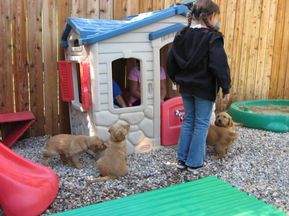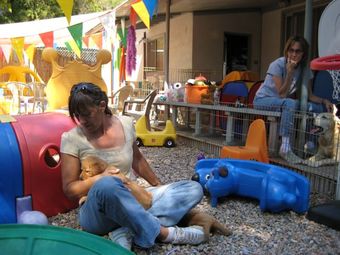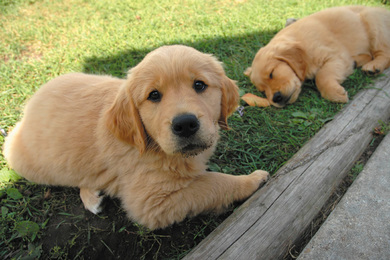temperament testing
PLEASE NOTE: We are not offering temperament testing at this time. Check back from time-to-time to see when we'll be providing it again.
Puppy Prodigies provides temperament testing to organizations, rescues and shelters. It should be standard protocol to have your puppies tested by an objective individual who the puppies have never met. If you'd like us to test a puppy, or an entire litter for you, please send an email to [email protected].
Temperament is inherited and innate. It can be described as a dog’s overall outlook on life. His drives, thresholds, traits, and instincts can give us insight into his temperament. The ideal dog will have an even temperament, and will not become overly emotional when exposed to day to day stimuli including sights, sounds and activities.
Temperament is inherited and innate. It can be described as a dog’s overall outlook on life. His drives, thresholds, traits, and instincts can give us insight into his temperament. The ideal dog will have an even temperament, and will not become overly emotional when exposed to day to day stimuli including sights, sounds and activities.

We begin making notes of each puppy from the time they’re born to get an early indication of their individual traits which can provide clues to subsequent development. Starting at six weeks of age, we start performing some tests to determine if they possess the traits and natural tendencies to be placed in an assistance dog program. These evaluations are complemented with temperament testing.
During this time we're looking at sociability, emotionality, problem solving ability, group dynamics, motor abilities and more. We typically find that temperament testing gives confirmation of the knowledge we have already gained about each puppy, and which show natural inclinations toward future assistance or career work. And, although we’re proponents of temperament testing, we realize it is not intended to predict future performance. Rather, it is used to evaluate a puppy's temperament at the time of testing, and helps to evaluate their basic personality.
We use the testing to isolate and quantify a puppy’s various strengths and weaknesses at the time of testing. When properly structured, the tests can provide some predictive clues of each dog's personality, sociability, and potential trainability. The testing helps to determine which puppies have the most suitable personalities for their future roles. And what type home would be best suited for each puppy.
The tests we use consist of a series of exercises that give information as to a puppy’s tendencies. The best time to do the testing is at 49 days old. At this age, the puppy’s brain waves are the same as an adult dog, except for experiences. Not all puppies will test the same, and the differences will assist in placing the puppy in the most appropriate environment.
During this time we're looking at sociability, emotionality, problem solving ability, group dynamics, motor abilities and more. We typically find that temperament testing gives confirmation of the knowledge we have already gained about each puppy, and which show natural inclinations toward future assistance or career work. And, although we’re proponents of temperament testing, we realize it is not intended to predict future performance. Rather, it is used to evaluate a puppy's temperament at the time of testing, and helps to evaluate their basic personality.
We use the testing to isolate and quantify a puppy’s various strengths and weaknesses at the time of testing. When properly structured, the tests can provide some predictive clues of each dog's personality, sociability, and potential trainability. The testing helps to determine which puppies have the most suitable personalities for their future roles. And what type home would be best suited for each puppy.
The tests we use consist of a series of exercises that give information as to a puppy’s tendencies. The best time to do the testing is at 49 days old. At this age, the puppy’s brain waves are the same as an adult dog, except for experiences. Not all puppies will test the same, and the differences will assist in placing the puppy in the most appropriate environment.

The test is performed by an objective person the puppies have never met. The components of the test include social attraction, following, restraint, social dominance, elevation dominance, retrieving, touch sensitivity, sound sensitivity, sight sensitivity, stability and structure. There are additional tests utilized for assistance dog candidates, such as a terrain test to ascertain the pup's willingness to walk across various textures, or testing responses to environmental stimuli. We also make note of problem solving abilities, energy level, natural inclination, curiosity, and other traits as indicated by the field of work the puppy is intended for.
Like any test, a puppy temperament test cannot be absolutely comprehensive, but it can assess particular qualities, skills or characteristics at that point in time. Environment plays a significant role, and temperament can be affected by the environment the puppy goes to. We work closely with our clients to determine the traits necessary for their future role, so we can be clear in what we're testing for.
If we determine that a puppy isn't appropriate for an assistance dog role, we will evaluate the temperament and traits that would be applicable for other programs such as search and rescue, scent detection, social therapy, etc. The puppies would then be placed with a program that best matches his/her traits.
Like any test, a puppy temperament test cannot be absolutely comprehensive, but it can assess particular qualities, skills or characteristics at that point in time. Environment plays a significant role, and temperament can be affected by the environment the puppy goes to. We work closely with our clients to determine the traits necessary for their future role, so we can be clear in what we're testing for.
If we determine that a puppy isn't appropriate for an assistance dog role, we will evaluate the temperament and traits that would be applicable for other programs such as search and rescue, scent detection, social therapy, etc. The puppies would then be placed with a program that best matches his/her traits.
"The best and most beautiful things in the world cannot be seen,
nor touched, but are felt in the heart"
Helen Keller
nor touched, but are felt in the heart"
Helen Keller


